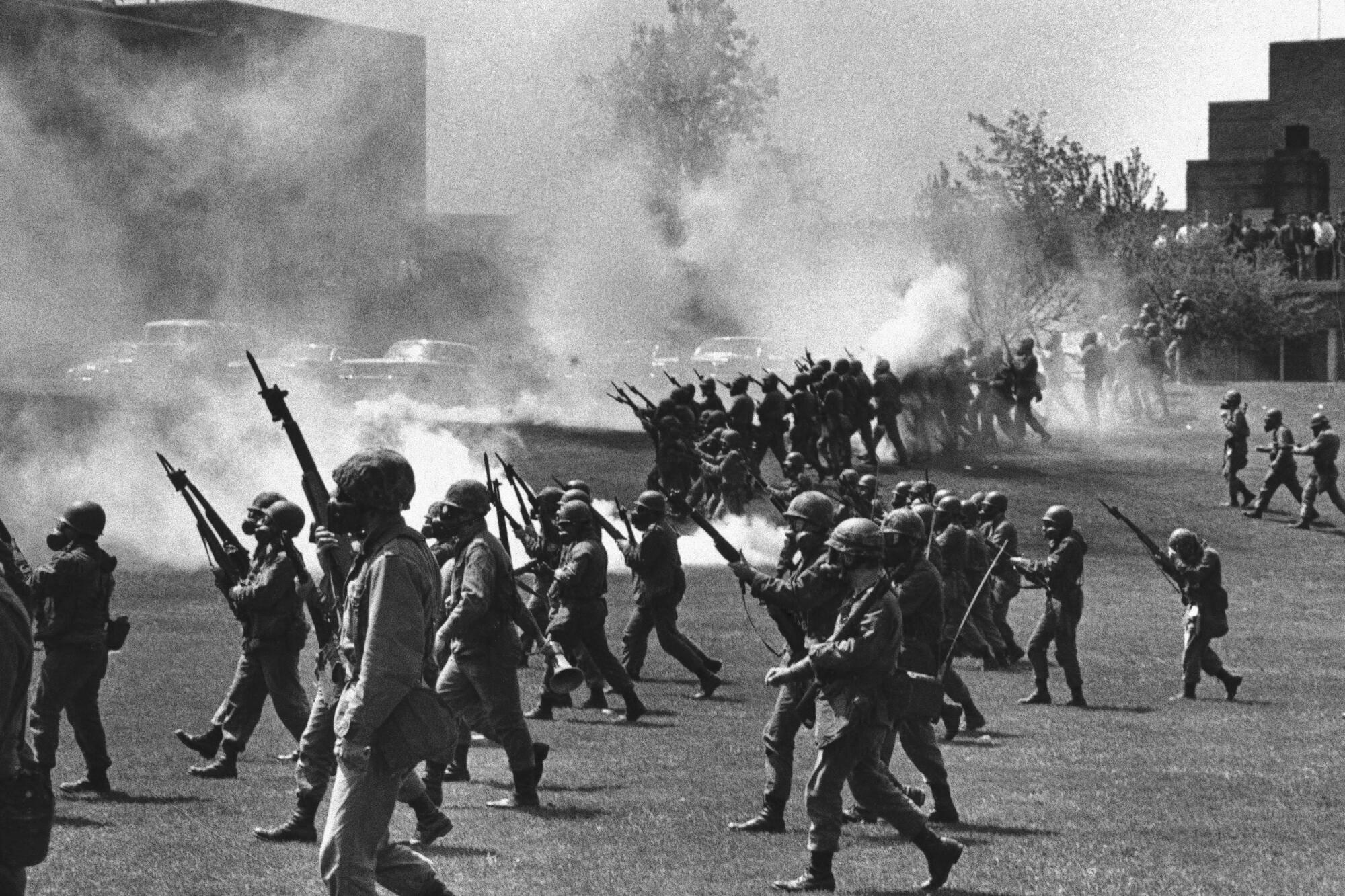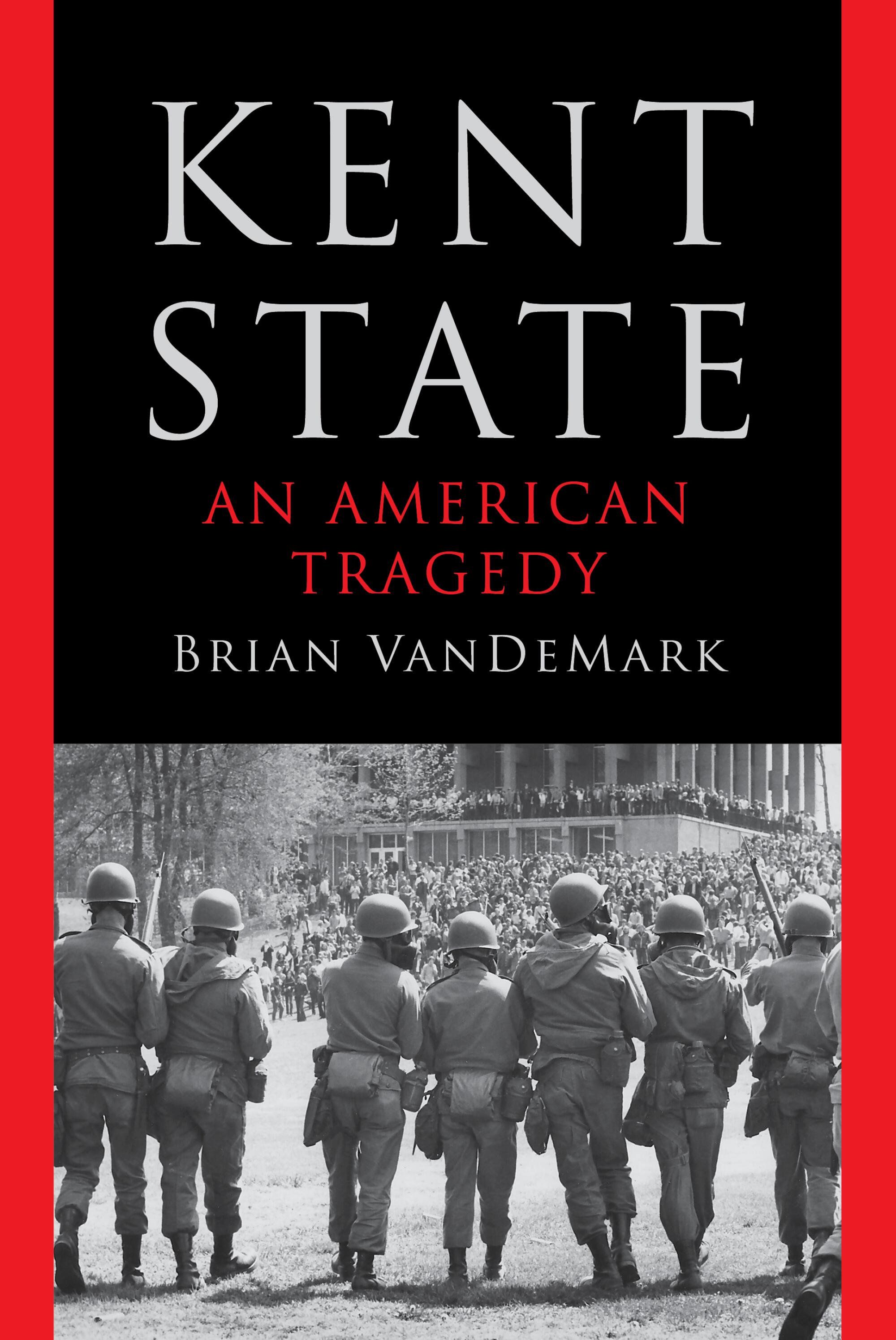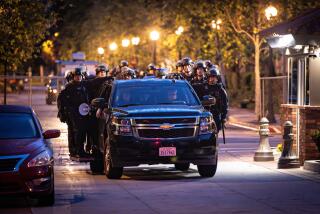
- Share via
Book Review
Kent State: An American Tragedy
By Brian VanDeMark
W.W. Norton: 416 pages, $35
If you buy books linked on our site, The Times may earn a commission from Bookshop.org, whose fees support independent bookstores.
Brian VanDeMark begins his book “Kent State: An American Tragedy” by sitting down with Matt McManus, who was a platoon sergeant in the Ohio Army National Guard on May 4, 1970. It’s an interesting choice that may raise questions among some readers. Such as: Why, in recounting the tragic campus killing of four antiwar protesters that spring day 54 years ago, are we starting the story by hearing from one of the killers? Is this really a “both sides” kind of story?
As quickly becomes clear in VanDeMark’s painful, meticulously researched and reported study, there are in fact more than two sides. Yes, there are the students, 13 of them shot by National Guard troops, four of them fatally. And the troops themselves, exhausted, untested, ill-prepared for their task, and to a large extent unsure what that task even was. And the inept, disorganized, jingoistic military and political leaders who set the stage for the massacre and, for the most part, refused to take responsibility afterward. And the parents of the slain, whose lives would never be the same. Finally, encompassing all of the above, there is a country torn asunder by rage, and marked by explosions literal and figurative.

As we learn later in the book, VanDeMark’s interview with McManus, who was 25 at the time, isn’t just a plea for sympathy, or a mere narrative starting point. It also breaks some news. Sitting at his home in Wooster, Ohio, McManus tells the author that he gave an improper, ill-advised and ultimately deadly order for the troops to fire their weapons into the air that day at 12:24 p.m. Some of the men complied, which is bad enough; bullets that go up must come down. Some fired into the ground. And others simply fired into the crowd. Nineteen-year-old Allison Krause, 20-year-old Jeff Miller, 20-year-old Sandra Scheuer, and 19-year-old William Knox were killed. It would have helped the cause of justice had McManus admitted to his error many years ago. But, as VanDeMark writes in the first sentence of the book, “People don’t withhold the whole truth unless the whole truth is too much to bear.”
In her memoir, Francine Prose embodies her generation during a paradigm-shifting era that included the fallout of Watergate and the Vietnam War.
The author then spends the next 397 pages hunting for that truth, as it was experienced by those involved. VanDeMark, who teaches history at the United States Naval Academy in Annapolis, Md., minces no words in assigning blame to those in the command structure who failed. On Robert Canterbury, the National Guard commanding officer that day: “Canterbury’s failure to announce that the guardsmen’s rifles were loaded with live ammunition was a reckless judgment made by a man whose hubris, stubbornness, and narrow-mindedness blinded him to the foolishness of his actions and escalated the risk of tragedy.” On Ohio Gov. Jim Rhodes, who, leading up to the shooting, histrionically compared student protesters to Nazi shock troops: “Instead of exerting a calming influence, Rhodes’s table-thumping theatrics added fuel to the fire.”

This is an admirably patient and thorough book, in which even the copious footnotes are worth poring over. VanDeMark introduces us to each of the students at the center of the tragedy. He takes us through the tumultuous weekend leading up to the Monday shooting, including the violent demonstrations in downtown Kent. He chronicles the futile, decade-long legal quest for accountability undertaken by survivors and victims’ families, and the even slower process of official remembrance on the part of the university, the city, the state and the country. And he takes every opportunity to remind us that the National Guard, many of whose ranks were serving in order to avoid fighting in Vietnam, shouldn’t have been on the university campus to begin with, a lesson worth heeding with recent calls from hawkish politicians to use the military in the face of student protests. As one guardsman at Kent State put it, “We didn’t have training in how to deal with student protests. We had training in how to kill people.”
A mix of history, memoir and biography, this book reflects on how time, perspective and stories left unwritten can shape our view of the past.
Beneath the chronicle of systemic failure and senseless slaughter is a portrait of a country in the throes of madness. One can quibble with the amount of space VanDeMark devotes to Students for a Democratic Society and its radical, violent and cluelessly revolutionary offshoot, the Weathermen, both of which had only indirect impact on the events of May 4. But you can also see the context that the author is establishing.
These were indeed days of rage, which enveloped everyone including the rock-hurling, obscenity-spewing protesters angry about the military occupying Vietnam and their campus. And the rage didn’t stop with Kent State. The ugliness and vitriol that dripped from the missives of Ohioans (and Americans) — insisting that even more students should have been shot, and telling the parents of the deceased that their kids were communist scum — is deeply saddening. VanDeMark never shies away from the fact that the response to Kent State was often shameful in itself.
Could something like this happen again? The question falls outside of VanDeMark’s purview here, but there remains a poisonous strain in American thought that insists political protesters are an enemy to be handled with whatever means is necessary. The overriding message of this book is a little simpler. Rock-wielding college students don’t deserve to be shot, and it is incumbent that we never forget those who were.
Chris Vognar is a freelance culture writer.
More to Read
A cure for the common opinion
Get thought-provoking perspectives with our weekly newsletter.
You may occasionally receive promotional content from the Los Angeles Times.












